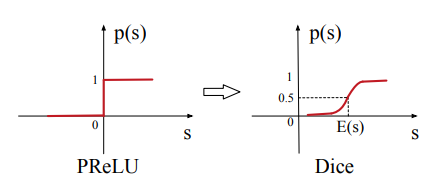
一、前言
最近在使用阿里的DIEN(Deep Interest Evolution Network for Click-Through Rate Prediction)模型优化我们自己的信息流推荐,阿里给了一个实现的github地址https://github.com/mouna99/dien,因为要使用tf serving部署服务,所以对代码做了重构,第一版上线后,没有明显的收益,再次review代码,发现里面有两个坑。其一是在做batch normalization的时候,训练的时候没有更新参数,其二就是Dice激活函数在预测的时候实现的有问题,修复后,auc有明显的提升(大概有1%的提升,在ctr预估场景,这个提升已经非常大了)。后面主要讲一下具体是怎么修复的。
二、Batch Normalization
Batch Normalization主要是用来解决Internal Covariate Shift(在神经网络的训练过程中,由于网络参数变化而引起隐藏层数据分布变化的过程)问题,Internal Covariate Shift主要会有两个方面的影响:
- 上层网络需要不断的调整参数来适应输入数据分布的变化,导致学习速度的降低
- 网络的训练过程不易收敛,容易形成梯度消失
Batch Normalization的提出缓解了上面两个问题
在训练阶段,变换公式如下:
其中X表示一个mini-batch的样本,
在测试阶段,计算的公式如下:
其中
可以看到,在训练阶段和测试阶段,Batch Normalization的计算是不一样的,我们再看一下tensorflow里面的函数原型:
@tf_export('layers.batch_normalization')
def batch_normalization(inputs,
axis=-1,
momentum=0.99,
epsilon=1e-3,
center=True,
scale=True,
beta_initializer=init_ops.zeros_initializer(),
gamma_initializer=init_ops.ones_initializer(),
moving_mean_initializer=init_ops.zeros_initializer(),
moving_variance_initializer=init_ops.ones_initializer(),
beta_regularizer=None,
gamma_regularizer=None,
beta_constraint=None,
gamma_constraint=None,
training=False,
trainable=True,
name=None,
reuse=None,
renorm=False,
renorm_clipping=None,
renorm_momentum=0.99,
fused=None,
virtual_batch_size=None,
adjustment=None):
"""Functional interface for the batch normalization layer.
Reference: http://arxiv.org/abs/1502.03167
"Batch Normalization: Accelerating Deep Network Training by Reducing
Internal Covariate Shift"
Sergey Ioffe, Christian Szegedy
Note: when training, the moving_mean and moving_variance need to be updated.
By default the update ops are placed in `tf.GraphKeys.UPDATE_OPS`, so they
need to be added as a dependency to the `train_op`. Also, be sure to add
any batch_normalization ops before getting the update_ops collection.
Otherwise, update_ops will be empty, and training/inference will not work
properly. For example:可以看到,里面的参数training表示是否为训练阶段,默认为False,也就是说如果我们不显示指定这个参数,Batch Normalization在我们的模型中是没有起任何作用。修改后的使用方式如下:
is_training = mode == model_fn.ModeKeys.TRAIN
hidden_layer = tf.layers.batch_normalization(inputs=hidden_layer, training=is_training)测试了一下在正确设置training后,学习率在0.7的前提下,auc从0.682提升到0.687。
三、Dice激活函数
Dice激活函数也是用来解决Internal Covariate Shift问题,和Batch Normalization有异曲同工之妙,定义如下:
我们将这个公式变化一下,设置
可以看到,Dice就是在BN上做了变换,github上有Dice的实现,代码如下:
def dice(_x, axis=-1, epsilon=0.000000001, name=''):
with tf.variable_scope(name, reuse=tf.AUTO_REUSE):
alphas = tf.get_variable('alpha'+name, _x.get_shape()[-1],
initializer=tf.constant_initializer(0.0),
dtype=tf.float32)
input_shape = list(_x.get_shape())
reduction_axes = list(range(len(input_shape)))
del reduction_axes[axis]
broadcast_shape = [1] * len(input_shape)
broadcast_shape[axis] = input_shape[axis]
# case: train mode (uses stats of the current batch)
mean = tf.reduce_mean(_x, axis=reduction_axes)
brodcast_mean = tf.reshape(mean, broadcast_shape)
std = tf.reduce_mean(tf.square(_x - brodcast_mean) + epsilon, axis=reduction_axes)
std = tf.sqrt(std)
brodcast_std = tf.reshape(std, broadcast_shape)
x_normed = (_x - brodcast_mean) / (brodcast_std + epsilon)
# x_normed = tf.layers.batch_normalization(_x, center=False, scale=False)
x_p = tf.sigmoid(x_normed)可以看到,其中BN的只实现了训练阶段,预测阶段没有实现,这样会导致相同的N条数据,按不同的batch-size作为输入,预估得分不一样,我们把它做一下修改:
def Dice(_x, axis=-1, epsilon=0.000000001, name='dice', training=True):
alphas = tf.get_variable('alpha_'+name, _x.get_shape()[-1],
initializer=tf.constant_initializer(0.0),
dtype=tf.float32)
inputs_normed = tf.layers.batch_normalization(
inputs=_x,
axis=axis,
epsilon=epsilon,
center=False,
scale=False,
training=training)
x_p = tf.sigmoid(inputs_normed)
return alphas * (1.0 - x_p) * _x + x_p * _x修改后,相同的N条数据,按不同的batch-size作为输入,预估得分保持一致,模型的auc大概能提升0.4%。
四、总结
- 深度学习里面有很多解决梯度消失和非线性变化的激活函数,还有一些解决过拟合的方法,tensorflow都做了很好的封装,使用起来很方便,但是要注意里面的一些参数设置,了解清楚实现的原理,要不然很容易采坑,调试起来也相当麻烦。
- 大多数论文都有开源实现的demo,但是真正要运用到具体的业务,还需要清楚其实现原理,一些坑只有上线了才能发现
- 额外补充:深度学习里面,很多时候会遇到高维稀疏特征,在广告和推荐场景很常见,在对ID特征做embedding的时候,embedding的大小很关键,之前有同学尝试过调整embedding size,离线Auc和线上指标都有不错的收益。
五、Reference
- [Zhou et al. 2018c] Zhou, G.; Zhu, X.; Song, C.; Fan, Y.;Zhu, H.; Ma, X.; Yan, Y.; Jin, J.; Li, H.; and Gai, K. 2018c. Deep interest network for click-through rate prediction. In Proceedings of the 24th ACM SIGKDD International Conference on Knowledge Discovery & Data Mining, 1059–1068. ACM.
- github.com/mouna99/dien.
- 天雨粟:Batch Normalization原理与实战




















 2万+
2万+











 被折叠的 条评论
为什么被折叠?
被折叠的 条评论
为什么被折叠?








